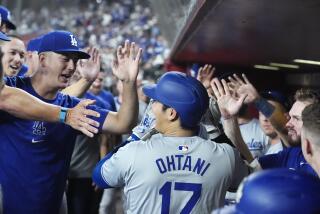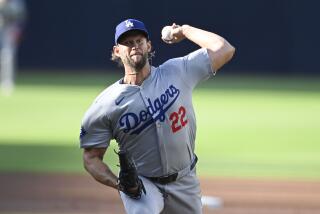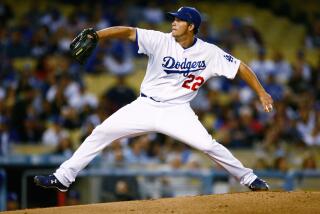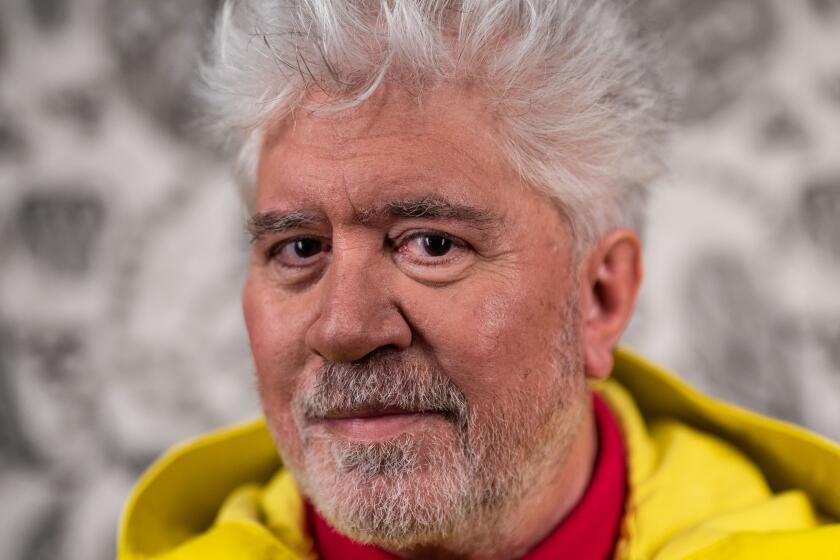‘The Best Team Money Can Buy’ profiles post-McCourt Dodgers
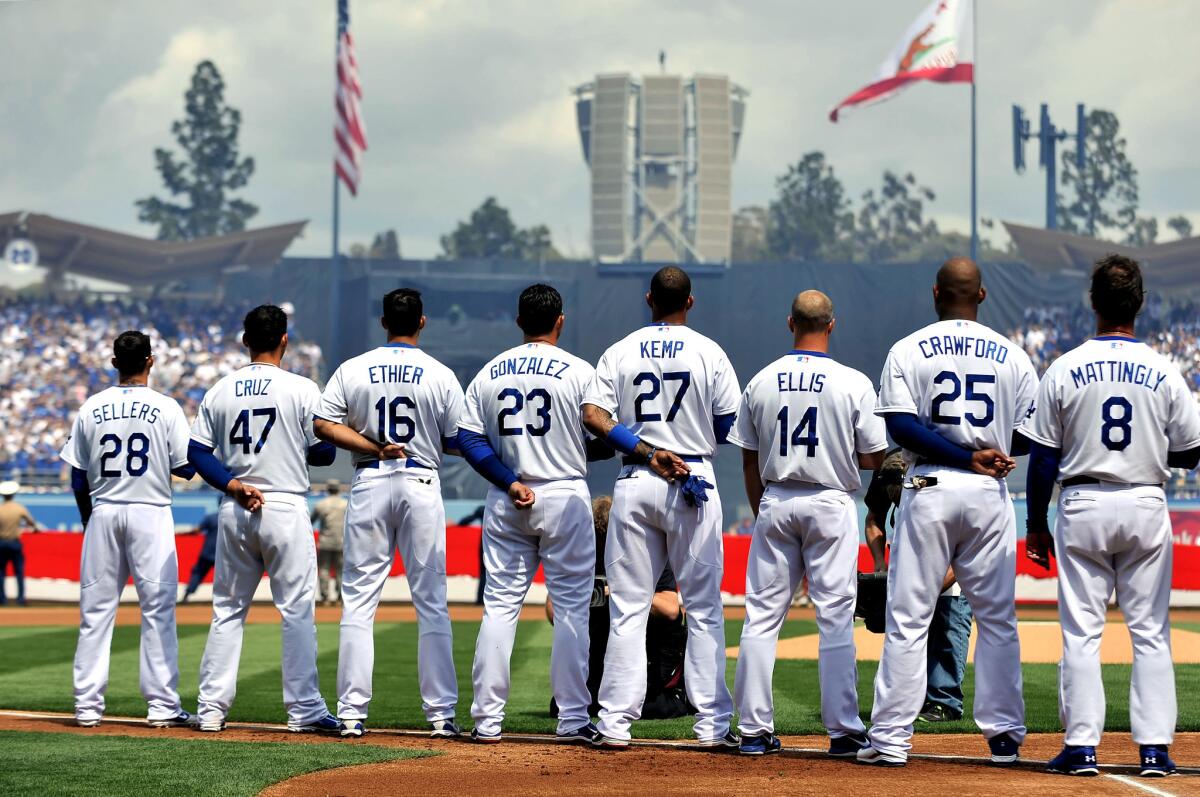
The Dodgers’ starting lineup remove their caps for the national anthem on opening day, April 1, 2013. Image from the book ‘The Best Team Money Can Buy: LA Dodgers’ by Molly Knight.
Molly Knight begins “The Best Team Money Can Buy: The Los Angeles Dodgers’ Wild Struggle to Build a Baseball Powerhouse” with a brutal moment: Clayton Kershaw’s collapse in Game 6 of the 2013 National League Championship Series. As anyone who was watching will remember, he gave up seven runs in four innings, losing the game, and the pennant, to the St. Louis Cardinals.
Kershaw was coming off a season for which he would win the Cy Young Award, striking out 232 batters, with a 1.83 ERA. He was supposed to be a lock — but that’s the trick about baseball: There’s no such thing.
It is a game that confounds our expectations, in which journeymen such as Bucky Dent become heroes, while stars like Kershaw or Don Newcombe become goats. Actually, the Kershaw-Newcombe comparison is apt, I think, since for all their regular-season heroics (Newcombe too was a Cy Young winner when the Dodgers played in Brooklyn but 0-4 in three World Series), both have had their troubles in October, when it counts the most.
MORE: 23 fiction books you’ll want to read -- and share -- this summer
In some sense, this can be read as a metaphor for Knight’s project, which tells the story of a franchise that has not won a World Series since 1988. For all the Dodgers’ recent successes — appearing in the NLCS in 2008, 2009 and 2013 — they have just not been good enough. That was supposed to change in 2012 when Guggenheim Partners bought the team from Frank McCourt for $2.15 billion, the most money ever paid for a baseball club.
Guggenheim controlling partner Mark Walter, Knight writes, “knew the experts were wildly undervaluing the ballclub because they failed to anticipate the tidal wave of cash that would pour into Chavez Ravine when the Dodgers signed their new television deal. … The invention of TiVo, DVR, premium on-demand channels, and Internet streaming sites like Netflix and Hulu meant that time-strapped consumers never had to sit through another commercial again if they didn’t want to. But people still wanted to watch sports in real time.” A year and a half later, Walter’s gamble paid off when Time Warner paid $8.35 billion for 25 years of Dodgers broadcast rights.
That’s just one of the fascinating perspectives Knight brings to the Dodgers saga, which is as much a drama of the owner’s bunker as it is of the baseball field. As a big-market team in a media capital, the Dodgers have access to an almost unlimited amount of money in the sport’s new economy.
This can be a mixed blessing; just ask anyone who, like me, rooted for the Yankees in the 1980s, when each year brought a new crop of high-priced free agents — and playoff futility. Money doesn’t win pennants, players do, and if deep pockets pay superstar salaries, they don’t necessarily do much for chemistry.
Consider the San Francisco Giants, who with an annual payroll of nearly $100 million less than the Dodgers ($172,821,277 to $276,373,625), have won three of the last five World Series, in part because of a clubhouse culture built around the concept of team. That has long been a problem for the Dodgers, both under McCourt’s ownership, which was, to put it charitably, dysfunctional, and in the era of the new regime.
As Knight asserts, “The 2013 Dodgers were less a team than they were twenty-five separate corporations,” a reference to the number of players on the squad.
“The Best Team Money Can Buy” is particularly strong in tracing how those 2013 Dodgers were built — a series of trades and free-agent signings, intended in part to engender good will with the fans. According to Knight, who covers baseball for ESPN: The Magazine, this was one of Walter’s priorities; the first deal he oversaw, a five-year, $85-million contract to Andre Ethier, was less about “overpaying an aging outfielder … [than] purchasing a city-wide public service announcement letting fans know the bad times were over.” . So too the signing of rookie Yasiel Puig a few weeks later, as well as the blockbuster trade, in August 2012, with the Boston Red Sox for Adrian Gonzáles, Josh Beckett, Carl Crawford and Nick Punto, “the largest payroll swap in MLB history.”
As to whether the deal was worth it, that remains an open question. Boston went on to win the 2013 World Series while the Dodgers were eliminated. Chemistry again, or the intangibles of the game? “The men on the Dodgers’ roster,” Knight notes, “owned twenty-five All-Star game appearances — but more Bentleys and Rolls-Royces than World Series rings.” According to one executive, they looked “more like a collection of fancy baseball cards than an actual team.”
One of the heroes of Knight’s book is Manager Don Mattingly (a member of those Yankees teams of the 1980s) who here becomes a voice of reason, keeping his superstars on an even keel. It was because of him as much as the emergence of Puig as a thrilling if undisciplined everyday player that the 2013 Dodgers, after starting 30-42, went 42-8 over their next 50, “the best fifty-game stretch of any team in over seventy years.” They won the division by 11 games and beat the Braves in a Division Series before imploding in the NLCS.
Knight chronicles all this in a matter-of-fact style that occasionally tilts toward the hyperbolic. Still, she knows her way around the clubhouse, and she writes about the game with authority.
“Because bullpens risked being burned out during the regular season,” she explains, describing the peculiar pressures of playoff baseball, “it was more valuable for a starting pitcher to go seven innings and give up, say, three runs than go five innings and give up none. In the postseason it was the opposite.”
The same is true in its way of her book. The Dodgers are a work in progress. As I write, they are in first place, although not by much — but Kershaw is having a challenging season, and he fell apart in the playoffs again last year. They have won nothing, proven nothing, and with the highest payroll in baseball, expectations are high. “April didn’t matter,” Knight writes. “October was all that did.”
The Best Team Money Can Buy: The Los Angeles Dodgers’ Wild Struggle to Build a Baseball Powerhouse
Molly Knight
Simon & Schuster: 320 pp., $26
MORE FROM BOOKS:
Get ready to be obsessed by these 29 page-turners
27 nonfiction books you’ll want to read -- and share -- this summer
Listen up: Here are 11 audiobooks you’ll want to ‘read’ this summer
Preview: Will Harper Lee’s ‘Go Set a Watchman’ live up to ‘To Kill a Mockingbird’?
More to Read
Sign up for our Book Club newsletter
Get the latest news, events and more from the Los Angeles Times Book Club, and help us get L.A. reading and talking.
You may occasionally receive promotional content from the Los Angeles Times.
